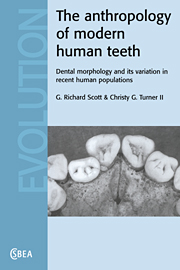 The Anthropology of Modern Human Teeth
The Anthropology of Modern Human Teeth Published online by Cambridge University Press: 05 September 2015
Introduction
As in other areas of evolutionary biology, human skeletal remains provide the only direct link to other past and living populations. Some skeletal biologists study bones and teeth to discern prehistoric population relationships while others are primarily concerned with temporal changes that can be interpreted in processual terms. These avenues of research provide insights into population history and adaptation, but, in terms of precedence, historical relationships must always be established before temporal trends in size, morphology, and other skeletal indicators are interpreted in processual terms. To illustrate this point, assume that collections of human skeletal remains from one region date to (a) 10,000, (b) 5,000, and (c) 1,000 years BP. Assume further that the three skeletal series show linear trends for a decrease in tooth size and an increase in stature from (a) to (b) to (c). One cannot attribute these trends to genetic changes (e.g., relaxed selection pressure), environmental factors (e.g., improved nutrition), or behavioral/ cultural modifications (e.g., new food storage or cooking techniques) until it is shown there is an ancestral-descendant relationship between (a) and (b) and between (b) and (c). Changes perceived as temporal trends might instead reflect new populations moving into our hypothetical region at times (b) and/or (c). It should not be assumed that two groups occupying the same space but at different times are somehow related. With the well-documented human penchant for moving around the landscape, this is not the case in many instances.
Tooth morphology has contributed to the resolution of a number of historical problems that have long attracted anthropological interest. For various reasons, dental morphologists have concentrated much of their attention on Asian and Asian-derived populations so our examples focus on Asia, the Pacific, and the New World. Fewer analytical studies have been directed at historical problems in Europe and Africa. Unfortunately for this review, but fortunately for future dental morphologists, there remain a myriad of historical questions beyond those addressed that await a systematic analysis of crown and root trait variation.
The Asian dichotomy: Sinodonty and Sundadonty
Asia, the world's largest continent with the largest living population, includes a wide diversity of habitats, from the world's wettest tropical rainforests (Assam), to deserts, steppes, mountains, and the coldest regions on the planet (Yakutia).
To save this book to your Kindle, first ensure no-reply@cambridge.org is added to your Approved Personal Document E-mail List under your Personal Document Settings on the Manage Your Content and Devices page of your Amazon account. Then enter the ‘name’ part of your Kindle email address below. Find out more about saving to your Kindle.
Note you can select to save to either the @free.kindle.com or @kindle.com variations. ‘@free.kindle.com’ emails are free but can only be saved to your device when it is connected to wi-fi. ‘@kindle.com’ emails can be delivered even when you are not connected to wi-fi, but note that service fees apply.
Find out more about the Kindle Personal Document Service.
To save content items to your account, please confirm that you agree to abide by our usage policies. If this is the first time you use this feature, you will be asked to authorise Cambridge Core to connect with your account. Find out more about saving content to Dropbox.
To save content items to your account, please confirm that you agree to abide by our usage policies. If this is the first time you use this feature, you will be asked to authorise Cambridge Core to connect with your account. Find out more about saving content to Google Drive.